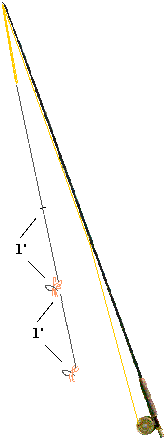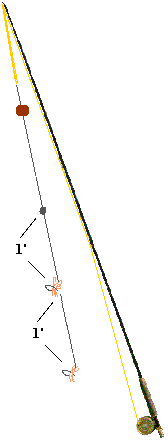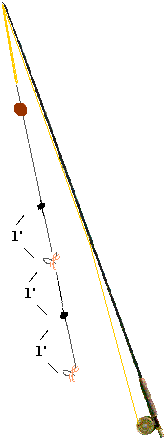Andy Kim's Fly Fishing Seminar
Andy Kim's rigging
I have three way setup for most of trout fly fishing I do:
Number one setup is for the dry fly or emerger or
streamer fishing
Number two setup is for the normal nymph fishing
Number three setup is for the fast and deep water nymph
fishing
Andy Kim's 3 way
rigging
 # 1 rigging |
 #2 rigging |
 #3 rigging |
Anatomy of the
river
Riffle: head part of the stream that is rippled and shallow.
Many people fish this type of water because trout tend to take flies aggressively.
Trout feed off riffles when there's no hatch.
Good for larva to pupa patterns here.
Run: below the riffle where the stream opens up wider and has similar current flow.
Good for pupa to emerger patterns here.
Pool: middle to end of the run where the current is slower and deeper before another riffle starts.
Good place for dry fly patterns here.
Collecting the aquatic insects
Carry a gold fish net or an old stocking to put over the net to collect the insects.
Also carry a small clear bottle or two to keep the collected insects for your data.
Make sure position upstream from the area you want to collect samples.
Basic anatomy of
insects
Three body sections: head, thorax and abdomen
Six legs
Two or four wings
Taxonomic ranking
or categories
Phylum> Class> Order> Suborder> Family> Subfamily> Genus> Species
Metamorphosis: different forms of insect's life stages
Complete metamorphosis: egg> larva> pupa> adult
Example: midges, caddis, beetles
Incomplete metamorphosis: egg> larva> adult
Example: mayflies, stoneflies, dragonflies, damselflies
San Juan river aquatic insects:
Mayflies (Ephemeroptera): mostly Baetis Tricaudatus-BWO, Ephemerella Inermis-PMD
Midges (Diptera): mostly Chironomidae-midges, Simuliidae-black flies, Culicidae-mosquitoes, Tipulidae-crane flies
Caddis (Trichoptera): mostly Brachycentrus Americanus-cased caddis
Scuds (Amphipoda): mostly Hyalella Azteca-freshwater shrimp
Worms (Annelida): mostly Tubificidae, Naididae, Lumbiculidae
Stoneflies (Plecoptera): mostly Isoperla Mormona-yellow stoneflies
Beetles (Coleoptera)
Snails (Gastropoda)
Dragonflies (Odonata): mostly Anisoptera, Zygoptera- damselflies
Water mites (Hydracarina)
Mayflies
Order Ephemeroptera (e-hpm-er-OP-ter-a): ephemera means short lived, ptera means wings
Many mayfly species are highly sensitive to pollution thus they are useful in biomonitoring analyses.
Four types of nymph: burrower, clinger, crawler, and swimmer
Majority of mayfly larvae have three tails, one set of
wing pads and six legs.
Nymphs go thru several molts as they grow.
The adults of all burrowers, clingers and swimmers have only two tails
Have two adult stages: both are winged and do not feed.
Sub imago: dun (after few minutes to few hours the dun will molts the skin) is a stage of sexual maturation in which the wings are but grayish.
Imago: after the stage of dun molts out and have longer legs and clear wings.
Fly patterns to match:
Nymph- Yong Wing, pheasant tail, gold ribbed hare's ear, RS2, WD 40, etc.
Adult- Yong Dry (baetis), PMD, BWO, Adams, etc.
Midges
Order Diptera (DIP-ter-a): di means two, ptera means wings
Adult diptera only have one pair wing.
Most of the adult looks like a mosquito.
All season flies for lakes and streams.
Chiromidae are the most known midges to the fishermen.
Some larvae are red colored (blood worm) due to the presence of hemoglobin that stores oxygen which allows them to live in areas that have limited oxygen conditions (high organic polluted areas including lake bottom).
Fly pattern to match:
Larva- Yong Blood, Yong Blondie, Yong Special, annelid, brassie, etc.
Pupa- Yong Special, Yong Flasher, Chocolate emerger, etc.
Adult- Yong Dry (midge), Griffith's Gnat, midge cluster, black fly, etc.
Caddis
Order Trichoptera (Tr-kop-ter-a): tricho means hair, ptera means wing
Adult looks like a moth.
Larva built case with small gravels, sand, sticks and leaves.
Usually they don't like cold water (above 45F in my opinion).
Fly patterns to match:
Larva-Yong Special, rock worm, cased caddis, etc.
Pupa-Yong Special,
Adult- elk hair caddis
Scuds
Order Amphipoda
Nickname as fresh water shrimp and they do swim.
Most of them like to hang around aquatic vegetations.
Fly patterns to match:
Adult-Yong JR, Yong OJ and any scud patterns.
Terrestrials
Includes dragonflies, damselflies, grasshoppers, crickets, beetles, cicadas, bees, etc.
You can use these patterns during summer to fall.
Fly patterns to match:
Yong JF, Y-Ugly, humpy, hopper, damsel, cricket, etc.
Importance of matching the hatch:
in my opinion 20% of trout are opportunistic, 40% of them are very selective
and the rest of the 40% can eat anything in any condition or can get very
selective.
Thus if you match the flies what they are feeding at
the time then you can catch 100% of the feeders!
What's in my vest?
Sunblock (30 SPF plus)
Polarized sunglasses (wear amber color on cloudy days and gray color for sunny days)
Tippets from 3x to 7x
Spare tapered leader
Assorted split shots
Floatant (filled with Albolene)
Yarns (polypropylene) and stick-on indicator
Nipper
Magnet
Hemostat
Fly boxes
Landing net
Gold fish net to collect samples and a small bottle
Raincoat
Camera and extra roll of film
Casting
Overhead cast: 10 AM to 2 PM arc is most common technique.
Do not bend your wrist on the back cast for more power.
If you have flexible rod then stop at 1 PM on back cast.
Roll cast: 9 AM to 2 PM arc is most common techniques.
Very good for when you have obstructions behind you.
Side arm cast: same as overhead cast except the rod is moving almost horizontal with surface to avoid the wind.
Recommend for the windy day condition or to fish undercut banks.
Puddle cast: same as overhead casting except during the forward cast just wiggle the rod tip before the line lands on the water.
Recommend for dry fly fishing.
Andy Kim's Pull Cast: same as overhead cast except pull the rod tip in about a foot and drop.
Recommend for emerger or dry fly fishing.
Andy Kim's Power Cast: It's somewhat in between roll and overhead cast.
I use this techniques just about any condition.
On forward cast make quick stop at 10 AM position and try to land the fly on the water first.
Knots
Nail knot: use for fly line to the leader.
Nail-les knot: use for fly line to the leader without the nail.
Improved clinch knot: use for tying flies on the leader.
Double surgeon's knot: use for tying two lines together.
Perfection loop: tied on the butt section of the leader to make a loop-to-loop connection on a fly line with a loop.
Blood knot: use for tying two lines together.
AK's knot: use for tying two lines together.
Andy Kim's leader setup for few inches to 6 feet deep-water condition
Butt section: 20 to 30 lbs monofilament for 2/5 of rod length.
Middle section: 5 to 10 lbs monofilament for 2/5 of the rod length.
Tippet section: 1 to 5 lbs monofilament for 1/5 of the rod length.
Mending the line:
Slow water- down stream mend
Fast water- up stream mend
Reading
the water
Trout are energy efficient minded thus they move around time to time for easy meal.
Finding a place where they are protected from the predators and plenty food is available is the key when you fishing a new place.
What to look for:
Drop offs (depth changes)
Bottom color changes
Large rocks above the water or submerged
Seam of the current
Undercut banks
Where multiple current meet